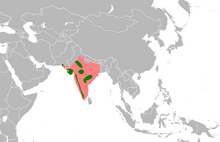Flag bustard
| Flag bustard | ||||||||||
|---|---|---|---|---|---|---|---|---|---|---|

Male (black) and female of the flag bustard ( Sypheotides indica ) |
||||||||||
| Systematics | ||||||||||
|
||||||||||
| Scientific name of the genus | ||||||||||
| Sypheotides | ||||||||||
| Lesson , 1839 | ||||||||||
| Scientific name of the species | ||||||||||
| Sypheotides indicus | ||||||||||
| ( Miller , 1782) |
The flag bust ( Sypheotides indicus , Syn . : Sypheotides indica , Eupodotis indica ) is the only species of the genus Sypheotides and is native to the Indian subcontinent. In the Red List of IUCN the flag Trappe as is "critically endangered" out.
features
The flag bust is a rather small representative of her family. The male reaches a body length of around 46 cm, the larger female around 51 cm. Both sexes weigh between 510 and 740 g.
The breeding dress of the male is particularly striking, which is characterized by two tufts of about 10 cm long, black feathers behind the ears, which are curved upwards and spatulate at the end. The head (with the exception of the white throat), the belly, the undersides of the wings and the long neck are colored black, a white band runs over the neck, which continues in the white shoulder coverts and arm wings. The back, the control feathers and the hand wings are covered with eye-catching golden-brown-black dotted patterns, which are blurred in the tall grass on the ground, but are clearly visible in the air due to the contrast to the rest of the plumage. In a sitting position, the white parts of the plumage form a ribbon separating the black underside and the neck from the patterned back.
The basic color of the female is sandy brown with dark pits that run down the sides of the neck and cover the back. In winter plumage, the male resembles the female, but his plumage shows more white parts. The long legs are yellow and bare.
The flag bust flies with fast flaps of its wings at low altitude and usually covers long distances. The call of the male is a rough croak, that of the female is a deep peooo .
distribution and habitat
The distribution area, which in 1870 still covered almost the entire Indian subcontinent, has since shrunk drastically and is now fragmented into a number of individual occurrences ( disjoint ). It currently includes Gujarat , Rajasthan , Maharashtra, and Madhya Pradesh . It is unclear whether the flag bust is still breeding in Pakistan , in Nepal it is a rare summer visitor . It inhabits high grassland with dense, high vegetation (such as ravenna grass ) or grain and cotton fields and occurs up to an altitude of 1300 m, but mostly in areas below 250 m.
behavior
The bustard feeds on insects and plants, especially grains and young sprouts. She is usually a loner and does not find herself in large groups. Like other bustards, it is predominantly a ground dweller.
Flag busters breed from July to October, depending on the rainy season. If this shifts forwards or backwards, the flag busters follow this shift. Male flag busters jump meters high out of the grass to advertise their partners, to show their conspicuous breeding dress from afar and at the same time to croak loudly. The bustard does not build a nest, but lays its eggs directly in the grass. The clutch consists of two to five, usually four, green to olive-brown eggs, which are speckled dark. They measure approximately 4.7 × 4.0 cm.
Existence and endangerment
The bustard flag has experienced a sharp decline in populations since at least the 1870s, which was initially mainly due to the hunt for the conspicuous males. More recently, however, the main cause of decline has been habitat destruction through the conversion of grassland into arable land, through overgrazing and the proliferation of the neophyte honey mesquite ( Prosopis glandulosa ). Between 1982 and 1989 the population decreased by 60% from 4,374 to 1,672 animals. By 1994, however, the population had recovered to 2206 birds. These strong population fluctuations are directly correlated with the amount of precipitation during the breeding season. In the event of a prolonged drought, there is a risk that the population will die out. The IUCN lists the bustard flag as "highly endangered" due to the strong decline in the population and the ongoing habitat destruction.
Sources and References
literature
- Tej Kumar Shrestha: Wildlife of Nepal: A Study of Renewable Resources of Nepal Himalayas. Steven Simpson Books, 2004. ISBN 9993359025 , pp. 331-332.
- John Barnard Dunning: CRC Handbook of Avian Body Masses . CRC Press, 2008. ISBN 1420064444 , p. 97.
- Hugh Whistler: Popular Handbook of Indian Birds. Read Books, 2007. ISBN 1406745766 , pp. 447-450.
Web links
- Sypheotides indicus in the endangered Red List species the IUCN 2009. Retrieved on March 1 of 2010.
- Videos, photos and sound recordings on Sypheotides indica in the Internet Bird Collection
- BirdLife Species Factsheet (English)
Individual evidence
- ↑ a b c d e f g Tej Kumar Shrestha: Wildlife of Nepal: A Study of Renewable Resources of Nepal Himalayas. Steven Simpson Books, 2004. ISBN 9993359025 , pp. 331-332.
- ↑ John Barnard Dunning: CRC Handbook of Avian Body Masses . CRC Press, 2008. ISBN 1420064444 , p. 97.
- ↑ a b c d e f Hugh Whistler: Popular Handbook of Indian Birds. Read Books, 2007. ISBN 1406745766 , pp. 447-450.
- ↑ a b Sypheotides indicus in the endangered Red List species the IUCN 2009. Retrieved on March 1 of 2010.
